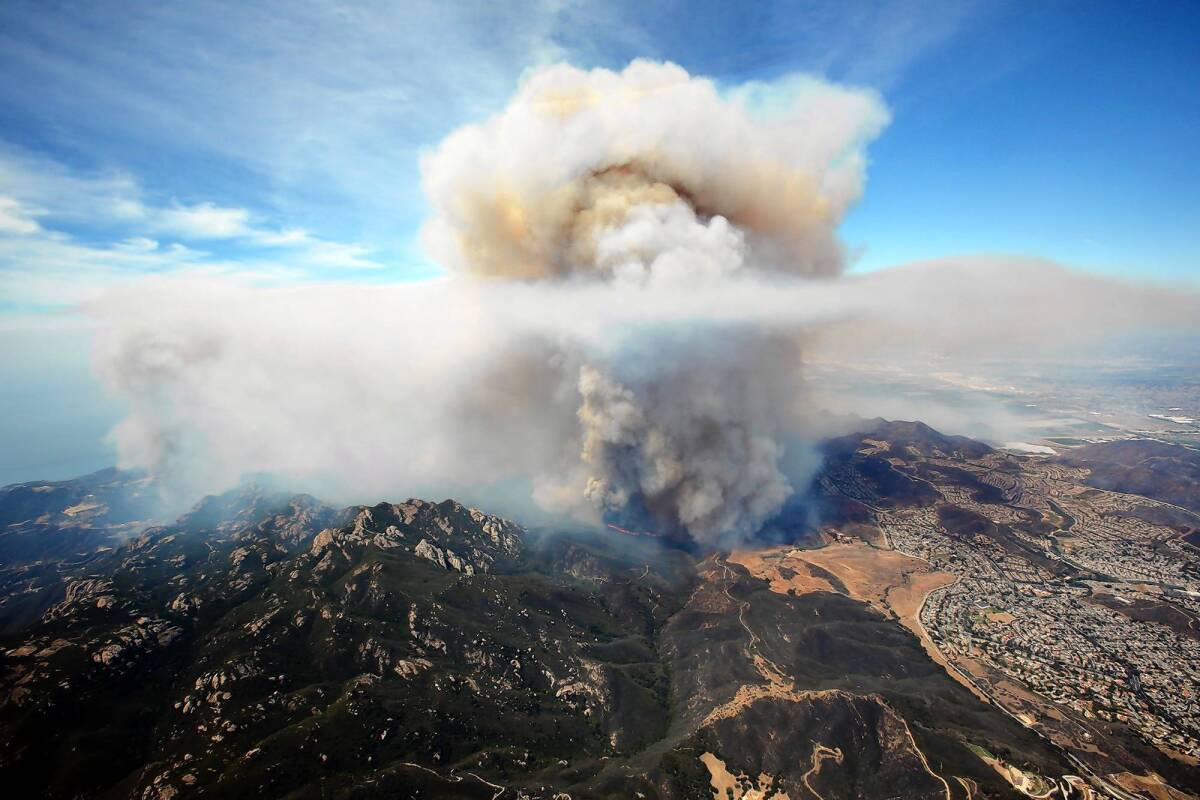Destructive 1993 blaze led to new firefighting strategy

- Share via
Scott Dettorre was a young firefighter in 1993 when the infamous Green Meadow wildfire swept through, leaving a path of destruction from Ventura County to Malibu.
The fire, which destroyed 53 homes and consumed 44,000 acres, caught firefighters unprepared and prompted officials to rethink the way they fight blazes driven by fierce Santa Ana winds.
This week, Dettorre helped lead the battle against the Springs fire, which like the devastating 1993 blaze covered a wide swath of the county. Dettorre, now a captain, said crews fought the blaze much differently this time.
Photos: Springs fire roars toward homes
It’s a game plan that as of Friday evening was showing signs of success. Although the fire licked against several subdivisions and hillside estates, it has largely remained confined to rugged wildlands and agricultural zones.
“With this fire, having experienced Green Meadow, our commanding officers realized much sooner that we were not going to get ahead of this fire,” he said Friday. “Consequently, we were able to put plans in place to minimize damage to a much greater extent. It is the lessons of Green Meadow that is allowing us to do what we are doing out here.”
The fire, which had burned more than 28,000 acres by Friday evening, ignited Thursday morning amid historically dry conditions and strong Santa Ana winds considered unusual for May.
Fire officials quickly determined that the leading edge of the fire was too dangerous to confront head-on.
“It became apparent very quickly that this fire was going to overwhelm us,” Dettorre said. “Instead of us being able to outflank the fire, the fire was outflanking us and putting all of the fire personnel in grave danger.”
Initially, firefighters worked from the point of origin and the flanks, trying to slowly pinch it off, said Ventura County Fire Capt. Mike Lindberry. But that strategy was abandoned in about two hours, and firefighters assumed a more defensive strategy, which included trying to protect important structures.
Lindberry and other commanders sent out strike teams, some with bulldozers to widen firebreaks, others with fire engines to protect property.
Many strike teams also deployed to defend subdivisions pressed against brush-covered hillsides and other open spaces. Throughout the day Thursday, TV stations showed dramatic footage of the fire roaring to the edge of communities — and in some cases seemingly surrounding them — before strike crews moved in and prevented the flames from entering the neighborhoods.
The battle at the head of the fire was joined by air.
Tanker planes dropped retardant in the path of the fire. Helicopters dropped water directly on the flames. Lindberry said the winds got so bad Thursday afternoon that the water tankers were grounded.
The fire raced through Newbury Park and Camarillo, burning a path to the sea through rugged parkland and farming areas. It consumed huge amounts of land, but firefighters were able to maneuver it away from large communities.
“The nervous part comes in with topography. There were some moments up on Deer Creek last night where it would flare up suddenly and take a run,” said Dettorre, who hadn’t slept in 24 hours.
During the Green Meadow fire in 1993, officials thought they could get ahead of the fire and battle it at the front. That turned out to be a dangerous move, making it more difficult to protect structures.
“We weren’t expecting that fire to take off the way it did. Because of that, we were behind the eight ball, playing catch-up constantly,” Dettorre said.
Both Dettorre and Lindberry said good urban planning was also an important factor this week. Ventura County has long required strict setbacks for fire protection measures for developments. These created important barriers that helped prevent flames from reaching subdivisions.
Lindberry said that’s one reason the Dos Vientos neighborhood in Newbury Park, which appeared besieged on multiple sides by flames Thursday, suffered virtually no damage.
Strict growth controls in the county have also proved helpful for firefighters.
Officials in the 1970s adopted a plan of keeping nearly all commercial and residential development within the boundaries of Ventura County’s 10 cities. That created greenbelt buffers between the cities and limited the growth of residential tracts on unincorporated land. Several major Ventura County fires burned large amounts of open space but spared neighborhoods. The massive wildfire in 2003 burned 172,000 acres but destroyed only 38 structures.
“Because of our history, we know where our fires are going to go,” Dettorre said.
catherine.saillant@latimes.com
Times staff writers Christine Mai-Duc, Kate Mather and Matt Stevens contributed to this report.
More to Read
Sign up for Essential California
The most important California stories and recommendations in your inbox every morning.
You may occasionally receive promotional content from the Los Angeles Times.













